Expanding your coffee repertoire beyond a standard drip coffee is easier than you might think. AeroPress and Chemex are two solid manual coffee brewing methods that don’t use electricity. However, there are some key differences between them, so read on to see where you land on the question of Chemex vs. AeroPress.
Chemex vs. AeroPress comparison
A Chemex looks very different from an AeroPress coffee maker. The plastic AeroPress is portable and versatile, making it excellent for traveling and camping. Meanwhile, the Chemex, made of durable borosilicate glass with wood trim, has a reputation for elegance.
These two manual brewing methods are more similar than meets the eye. Both have their main features: the user puts in coffee grounds and then adds hot water to make coffee without electricity. However, you will need an electric kettle or another heat source for boiling water.
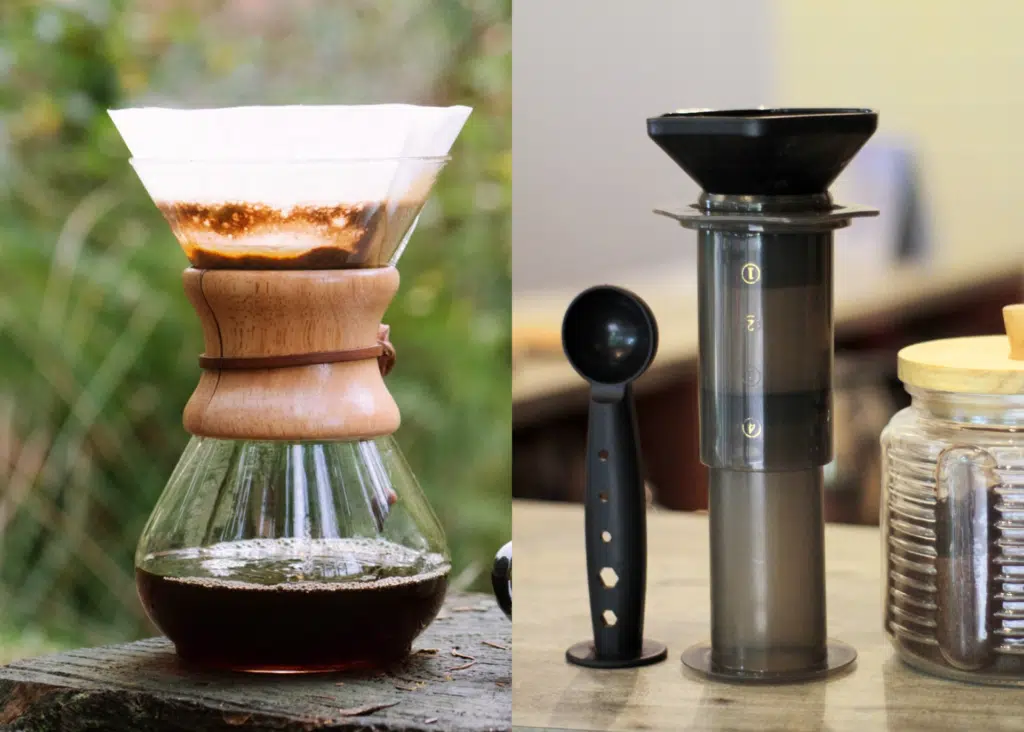
Ease of use
Both Chemex and AeroPress are pretty easy to use and suitable for beginners. However, if you are still building confidence in your coffee brewing skills, you may want to know which brewing method is mistake-proof.
Chemex
A Chemex coffee maker is a type of pour-over coffee maker. You put in a filter and grounds, pour in hot water, and then the coffee drips into the glass carafe below.
The main trick of using a Chemex is to pour a little bit of water, wait a few moments, and then slowly pour the remaining water over the coffee grounds. There is even a special coffee scale with a built-in timer to help you time the water pouring to get the optimal extraction of coffee.
A great thing about a Chemex is that the lower half is attached to the filter cone, so the coffee can’t go anywhere except where it’s supposed to go. However, if you try to rush for a faster brewing time, you might not get as good coffee as you could.
With a Chemex, you might have to devote more attention to the coffee grind than you do with AeroPress. Chemex performs best with coffee at a slightly coarser grind than you might not get in a store-bought package of coffee, but not as coarse as coffee ground for cold brew. If you have a coffee grinder at home, you will need to grind your coffee beans with a medium-coarse grind setting. Chemex coffee can develop bitterness if over-extracted, and using a fine grind can cause this.
AeroPress
An AeroPress is a tube, known as a brewing chamber, with a plunger. The tube sits over the mug you want to brew your coffee into when you make coffee.
You set up the tube with a circular paper filter at its bottom, and then you add coffee on top of the filter. Then, you pour hot water into the tube. You then stir the water with the ground coffee for about ten seconds. Then, finally, you depress the plunger to push the water through the grounds and brew coffee. The only thing you have to be extra careful about with an AeroPress is that it could potentially get bumped off of the mug it’s supposed to be brewing into. It can make a serious mess on your kitchen counter while brewing.
An AeroPress can perform well with coffee at the medium or espresso grind size, though you might want to let it steep a little longer if you use the medium grind size. This range of coffee grinds is similar to what you’d find in store-bought packaged coffee, so AeroPress can be best if you don’t want to grind your beans.
Winner
Though neither AeroPress nor Chemex is complicated to use, AeroPress wins as it has a faster brewing time. Also, it is less likely to require you to grind coffee beans.

Brewing time
If every minute counts in your morning routine, it may be important for you to have a coffee brewing method that gets the job done quickly.
Chemex
Brewing with a Chemex requires a bit of waiting in the process, which is the major drawback for those in a rush. Chemex manufacturers recommend that you wet the ground coffee in the filter with a small amount of heated water and then wait about thirty seconds for them to “bloom.” It helps the coffee expand. If you’re not in a hurry, it’s an excellent opportunity to hang out in the kitchen and enjoy the coffee aroma.
Even after the bloom, you have to be careful to slowly pour more water over the coffee grounds, working in a circular motion to wet all the grounds. Depending on your Chemex size, the coffee can take a while to finish brewing into the lower half of the glass vessel.
AeroPress
AeroPress has a fast and convenient brewing process. Once you add water to the brewing chamber, stir it with the ground coffee for ten seconds. If you want cold brew instead of hot coffee, you can use room-temperature water and stir it with the grounds for one minute. Either way, you then push the plunger down. At most, the whole process should take barely over one minute.
Winner
AeroPress has a faster brew time than Chemex.
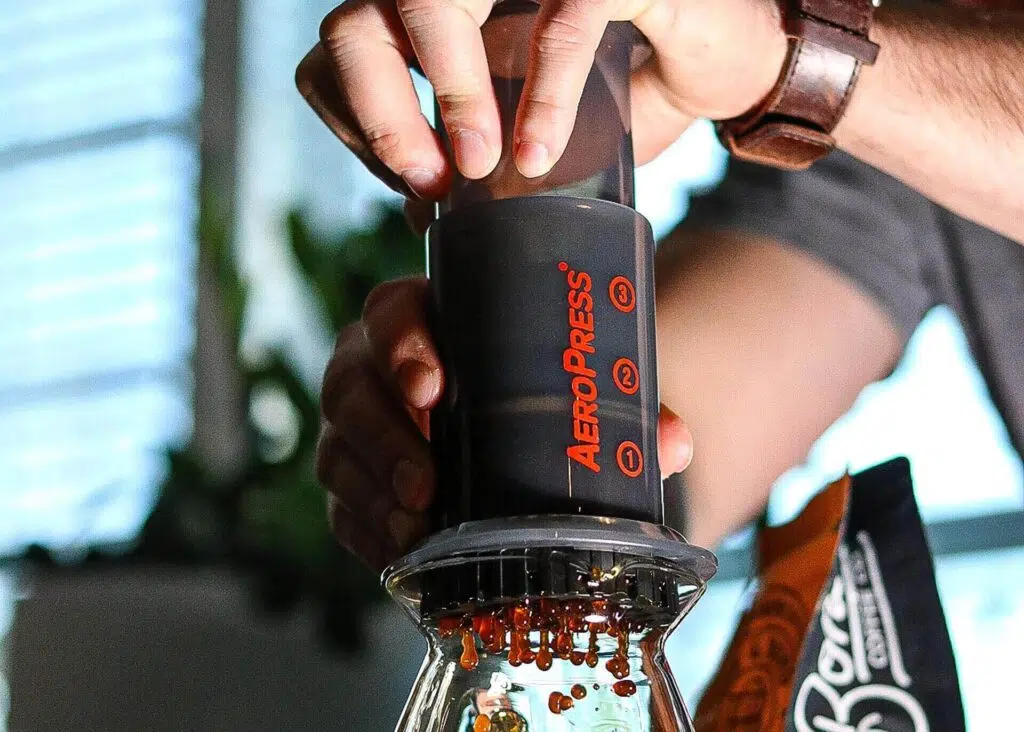
Capacity
Brewing capacity is an apparent difference between Chemex and AeroPress. The better choice for you between the two will depend on how much coffee you want to make at a time.
Chemex
Chemex coffee makers come in different sizes, but most of them make more than one cup of coffee at a time. Therefore, Chemex is the ideal choice for making coffee for more than one person. However, if you only want a single cup, you need to get a smaller Chemex.
AeroPress
One of the most well-known advantages of AeroPress is its portability. Given its small size, AeroPress is designed to make only one cup of coffee at a time. If you know you only want that small amount of coffee, an AeroPress might be best for you. While an AeroPress can be cajoled into making three servings at once, it is a more complicated process than making the single-serving AeroPress is best known for.
Winner
Chemex is the way to go if you need to make bigger batches of coffee at a time. However, if you’d want to brew several cups of stronger coffee, you may want to consider Moka Pot vs. Chemex option.
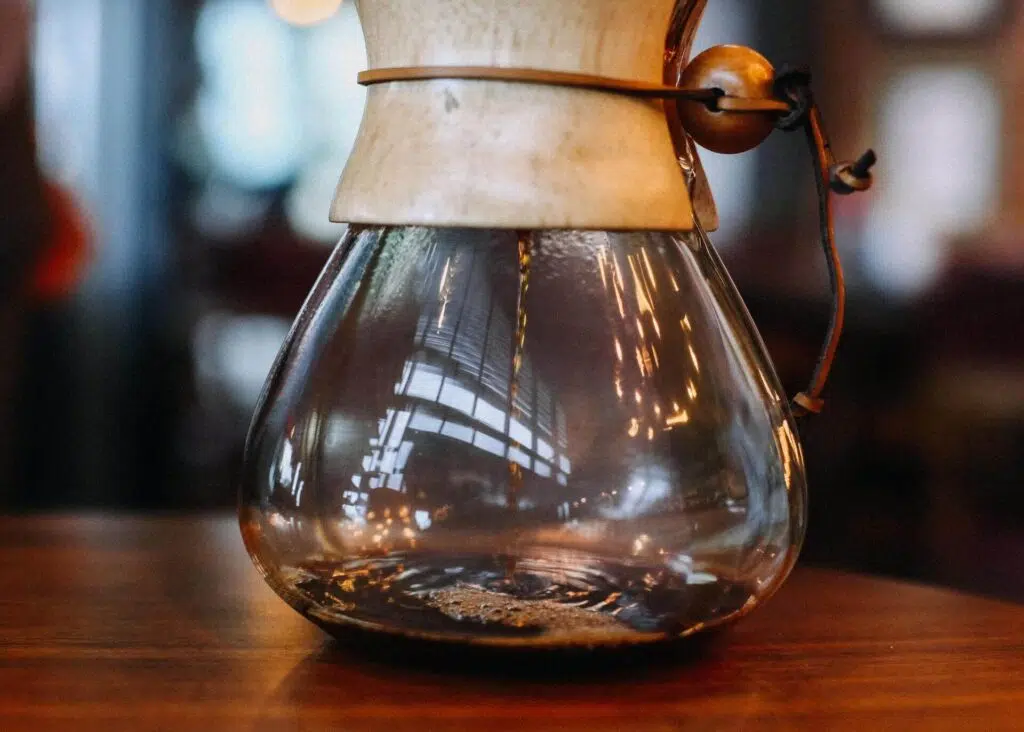
Taste
Though you might drink coffee for the caffeine, the taste undoubtedly matters too. Knowing how different brewing devices affect the taste of coffee can help you decide on the AeroPress vs. Chemex question.
Both AeroPress and Chemex use paper filters, so they have the same pros and cons in that respect. The paper filter keeps sediment out of the resulting brew, giving your coffee a clean taste. However, the filter also removes most coffee oils responsible for rich flavor.
Chemex
Chemex coffee is known for its clean taste. The thick filter gives it a lighter body and milder flavor than you would get with a different brewer. Therefore, this manual brew technique is ideal for coffees that have delicate citrus notes or floral notes that might get lost with other brewing methods. Though Chemex has a longer brew time than AeroPress, the upside of waiting is that the slower extraction draws out these more complex flavors.
The downside of a Chemex brewer’s thick filter is that it can sometimes give the coffee a paper flavor. Tips for solving this problem include rinsing the filter with water before use.
AeroPress
AeroPress coffee has a bolder flavor than Chemex coffee because it uses the immersion brewing method, even though the ground coffee stays in the water for less than a minute.
The inverted method, an advanced variation on AeroPress use, increases extraction and produces a more intense flavor by keeping the grounds in the water longer. It is closer to how a French press works.
Though AeroPress does not generate the pressure of an espresso machine or a portable espresso maker, the resulting brew is similar to an Americano or espresso shot because it is concentrated, strong coffee. Therefore, it can be used when you don’t have an espresso machine for making a latte at home or any other espresso-based drink.
A common question about AeroPress is whether the plastic body affects the taste of the coffee, as plastic can, unfortunately, leach flavor when it gets hot. However, the AeroPress handles this issue better than one might think, as you pour hot water into it instead of heating it inside it.
Winner
The Chemex method makes a lighter-tasting coffee. However, if you prefer more full-bodied coffee or you want to do something creative like make a latte at home, AeroPress is a better choice.
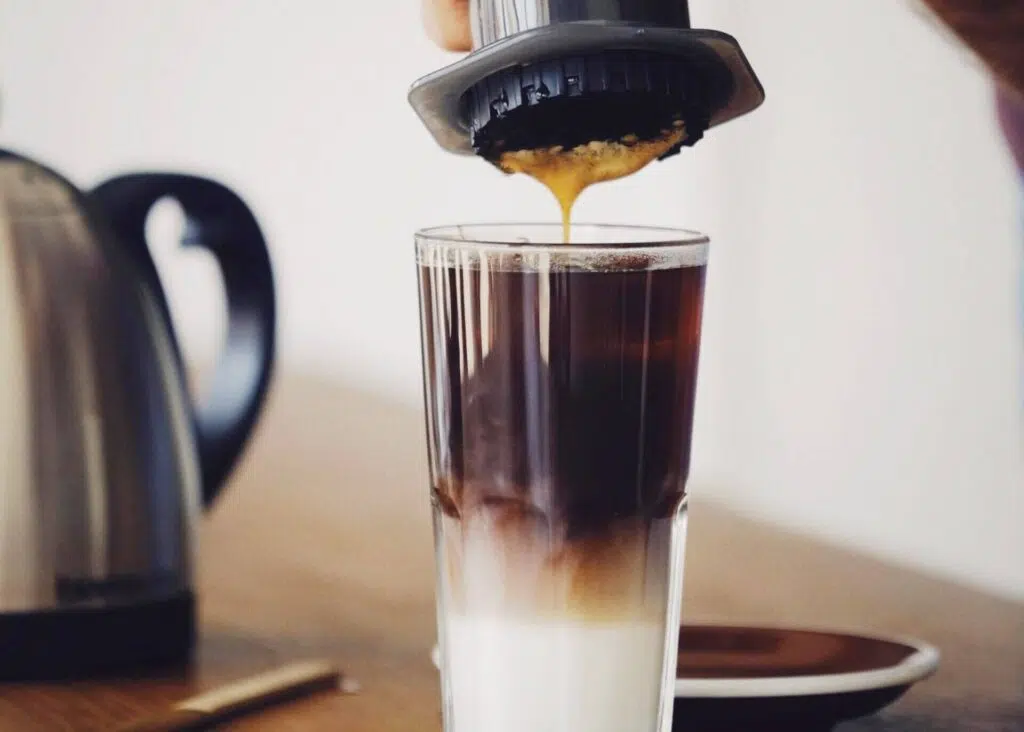
Cleaning
Cleaning your coffee maker is an important part of the brewing process that is often overlooked. As you try to decide between AeroPress vs. Chemex, make sure the clean-up for the manual brewing method you choose is compatible with your preferences.
Chemex
Cleaning Chemex is pretty straightforward. First, remove and discard the paper coffee filter. It is worth noting that Chemex filters are compostable, so don’t rush to throw them into the bin. Next, if your model of Chemex has a classic wooden collar and leather tie (some of the newer models don’t), you have to remove that. Then, the borosilicate glass carafe can be hand washed with soap and water. It can also go in the dishwasher.
AeroPress
Cleaning an AeroPress is easy because the compressed coffee grounds completely eject from the AeroPress after brewing without making a mess. After that, the AeroPress usually doesn’t need more than a quick rinse with water.
The AeroPress is dishwasher safe on the top rack of the dishwasher if you feel it needs additional cleaning. However, some users find that the plastic of the AeroPress can absorb the flavor of your dishwasher detergent. Handwashing with soapy water will work too.
Winner
The AeroPress has an advantage in terms of cleaning because you can often get by with just a quick water rinse. However, cleaning a Chemex is not that difficult, either.
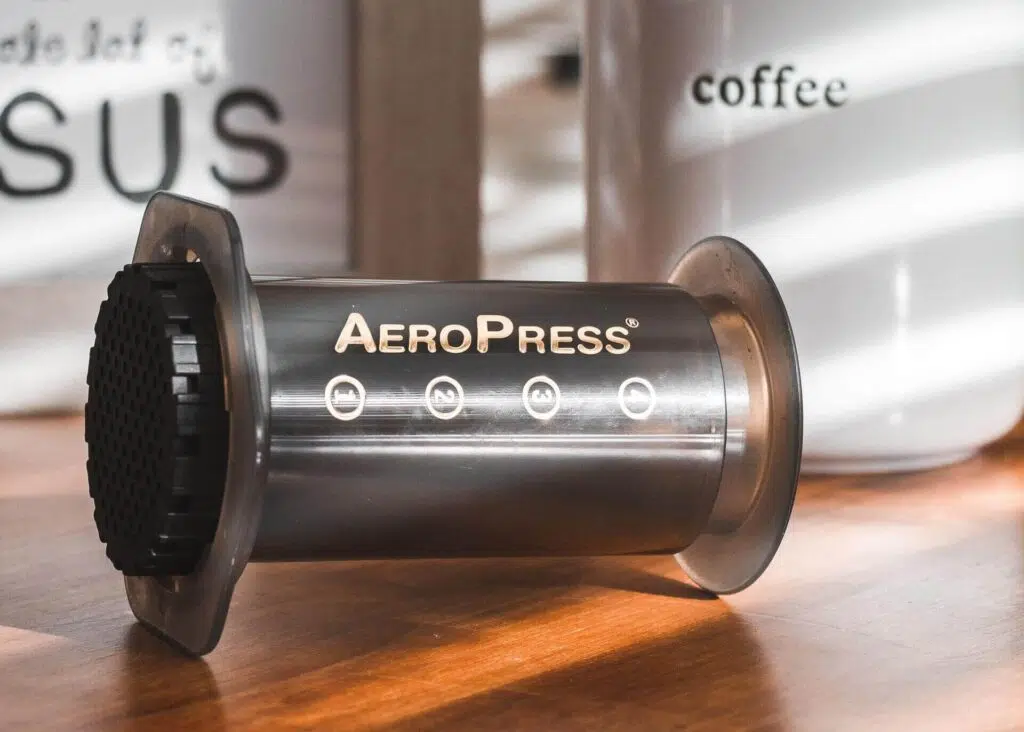
Cost
As you choose between manual brewing methods to improve your coffee experience, you may need to consider the price of the brewing equipment you are looking at. However, the price of the coffee maker itself may not be the only cost you need to consider.
Chemex
Chemex coffee makers start at around $40, and the price increases for models with greater capacity. These brewers, known for their simple design, don’t have parts that are likely to break and need replacement.
However, an ongoing cost with Chemex is its paper filters. Generic paper filters used in other pour-over coffee makers are generally not suitable for Chemex because the Chemex cone is taller than a generic filter. In addition, the name brand filters can get expensive, costing about $10 for a pack of 100, and they aren’t as widely available as the generic filters. You can, however, get a reusable stainless steel filter that fits in a Chemex.
AeroPress
An AeroPress retails for around $30, which is lower than a Chemex cost. An AeroPress also uses a paper filter in a non-standard size, but its filters are cheaper than Chemex filters, more like $5 for a box of 350. You can also get a reusable metal filter for your AeroPress. It will give your coffee a richer flavor with natural oils and more sediment, similar to French press coffee.
AeroPress has more parts that can be broken or misplaced than a Chemex. Nevertheless, getting replacement parts for AeroPress, such as a rubber gasket if it is not sealing or a plunger, is easy and can extend your coffee maker’s lifespan.
Winner
In most cases, AeroPress is cheaper than Chemex. However, a Chemex may be more durable.
As a coffee lover, you have many different options for brewing your coffee. The AeroPress is known for its versatility. It is the best way to have the perfect cup of strong coffee on the go, especially if you have a lifestyle that involves a lot of traveling. However, if you are an aspiring home barista, you can enjoy a slower coffee brewing process using a Chemex.
Looking for more coffee brewing options? Check out my AeroPress vs. Moka pot comparison to make a better decision!
